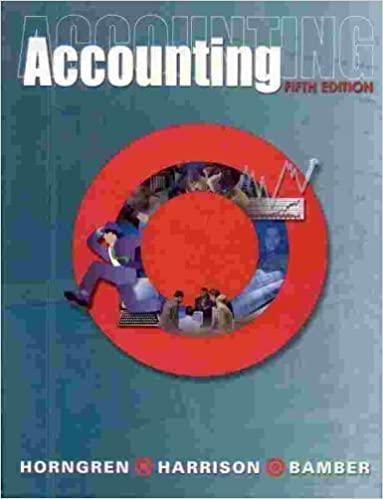Project 1 Quick Trades, Inc., began operations in 1988 as a regional discount brokerage firm. The company
Question:
Project 1 Quick Trades, Inc., began operations in 1988 as a regional discount brokerage firm. The company grew quickly because of its low trading fees. In the late 1990s, Quick Trades began offering on-line trading. Quick Trades established two types of accounts: a standard service account that provides restricted access to investment advice, and an extended service account for more active customers who maintain a minimum investment balance. Quick Trades charges customers an annual flat service fee plus a per-trade fee. Quick Trades CEO Mary Pownall is not happy with the company's recent profits and growth. As on-line trading has become more and more competitive. Pownall tried to increase the extended service accounts. Unfortunately, this has not helped profits. To remain competi- tive, she now believes that the basic per-trade fee for standard service accounts must be cut to $10. Other firms are starting to lower their per-trade charges to $10 per trade, but Pownall just does not understand how they can charge so little. Controller Joan Lipe wonders whether Quick Trades' cost accounting system may be part of the problem. While Quick Trades has invested significantly in the latest Internet trading software, the company still uses its original accounting software. The accounting software does not trace any costs directly to customers. The company simply assigns total indirect costs to customer lines (standard service accounts and extended service accounts) based on the total number of trades processed. Lipe thinks that activity-based costing may be helpful, but Pownall wants to see how an ABC system could be helpful before investing in new accounting software. Lipe assembles an ABC team that includes her assistant, a broker, and the information technology manager. The team begins by identifying three of Quick Trades' critical activities: Processing trades Personalized broker investment advice Answering customer account inquiries The ABC team then analyzes the company's total indirect cost of $10,500,000. Classifying the components of this total indirect cost into the appropriate activity cost pools leads to the following estimates: Assignment of Indirect Costs to Activity Cost Pools Indirect Cost Activity Cost Pool to which Indirect Cost Is Assigned Salaries of trade processing personnel Trades processed Information technology Trades processed Brokers' salaries Broker support Estimated Total Costs $ 1,120,000 3,430,000 3,100,000 2,300,000 Investment research support Customer support staff department Total indirect costs Broker support Customer account inquiry 550,000 $10,500,000 The team identifies the following cost drivers for each activity pool: Activity Cost Pool Activity Cost Driver Trades processed Broker support Customer account inquiry Number of account inquiry calls Number of trades processed Number of broker contacts The ABC team estimates that the total number of standard and extended service customers will require the following total resources: The ABC team estimates that the total number of standard and extended service customers will require the following total resources: Activity Cost Driver Trades processed Broker contacts Account inquiry calls Activity Cost Drivers by Customer Line Total Number of Units of Activity Cost Driver Used by Standard Service Customers 450,000 trades 10,000 contacts 50,000 calls Total Number of Units of Activity Cost Driver Used by Extended Service Customers 425,000 trades 90,000 contacts 200,000 calls Quick Trades currently has 15,000 standard service customers who average 30 trades a year. and 8,500 extended service customers who average 50 trades a year. Split your team into two groups. Each group should meet separately before the entire team meets. Required Group 1: Use the original, less-refined cost system that assigns indirect costs based on the total number of trades processed and 1. Compute the indirect cost allocation rate. 2. Use the indirect cost allocation rate to determine the total indirect cost allocated to
(a) the standard service customer line, and
(b) the extended service customer line. 3. Compute the indirect cost per
(a) standard service customer, and
(b) extended service customer. 4. Based on this analysis, can CEO Mary Pownall cut the basic per-trade fee to $10 per trade (not per customer) for the standard service customer line? 5. What warning signs indicate that Quick Trades' cost accounting system may be broken? Do you believe that Lipe is correct to question the original cost system? Explain. Group 2: Use the proposed activity-based cost (ABC) system to compute 1. The indirect activity cost allocation rates for each of the three activities. 2. The total indirect activity costs allocated to
(a) the standard service customer line, and
(b) the extended service customer line. (Hint: This is the sum of the indirect activity costs allocated to each customer line for all three activities.) Total 875,000 trades 100,000 contacts 250,000 calls ACTIVITY- 3. Compute the indirect cost per
(a) standard service customer, and
(b) extended service customer. 4. Can CEO Mary Pownall cut the basic per-trade fee to $10 per trade (not per customer) for the standard service customer line? Why or why not? Team meeting: After each group has completed its individual assignments, the team as a whole should meet to compare results. The team should prepare a memo to CEO Mary Pownall that (1) explains why the costs are so different under the two cost systems, and (2) provides a recommendation along with a justification for which system Quick Trades should use for pricing decisions. Use the following format for the memo: Date: To: From: CEO Mary Pownall ABC Team Re: Memo Differences between Quick Trades' present cost system and an ABC cost system
Step by Step Answer:

Accounting
ISBN: 9780130906991
5th Edition
Authors: Charles T. Horngren, Walter T. Harrison, Linda S. Bamber, Betsy Willis, Becky Jones





